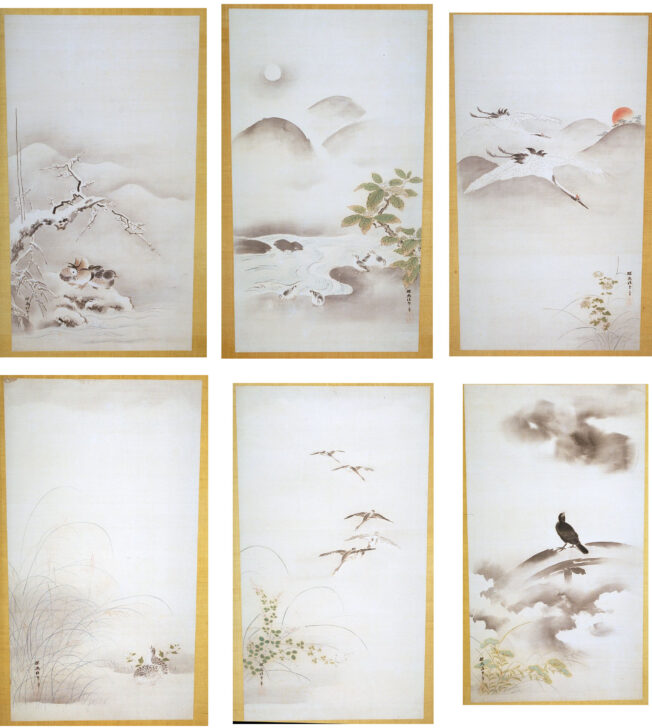One of a pair of six-fold screens
Kanō Tan'yū

Description
Copies and Invention in East Asia (August 17, 2019 - January 5, 2020)
The Kano school was the official painting school of the Tokugawa shogunate in Edo period (1615–1868) Japan, and dominated the production of paintings for the ruling military class. Students spent all day, everyday copying past examples of painting (called funpon). This qualified them to produce high-quality “copies” of historic Kano school paintings for new buildings, festive occasions, and important gift-giving occasions. For the client, these copies had the same value as the originals. While these screens bears the signature of Kano Tan’yū (1602– 1674), a key early figure in the Kano school, the mounting style and pristine condition suggest they were probably created in the nineteenth century. There was no intent to deceive. Kano school painters often added the signatures of the original painters to copies of their work, with the approval of the school and the clients. A painting with Kano Tan’yū’s signature was an essential part of a samurai household, and it did not matter if it was by the artist himself.
Gallery Rotation Fall 2011
Kano Tan’yu
Japan, 1604–1674
[Six of] The Twelve Months
19th century
Edo Period (1615–1868)
Six-fold screen, ink and light color on paper
Museum purchase made possible by the Margaret Watson Parker Art Collection Fund, 1965/1.178
Depictions of the seasons have a prominent place in the tradition of the Kano School (the official school of painting of the Tokugawa shogunate) and Japanese art. Six-fold screens such as this, most likely one of a pair, are meant to represent six of the twelve months of the year, with keen attention paid to the birds and flowers associated with each. Although this screen bears Kano Tan’yu’s signature, it was probably created by his studio or by followers working in this famous artist’s style.
Painters were not alone in their masterful use of seasonal references—poetry also drew heavily on such motifs and exchange often took place between these genres, with poems inspiring painted scenes and paintings finding representation in poetic verse. The following late Heian (794–1185) and early Kamakura (1185–1333) period poems would have been part of the artistic dialogue that informs the motifs on these screens:
Spring is the cherry blossom
Summer is the cuckoo
Autumn is the moon
And in winter,
the shimmering snow is fresh to the eye.
Eihei Do-gen (1200–1253)
In the evening, the biting autumn wind blows through the field
and quails cry in the Village of Deep Grasses
Fujiwara Toshihari (1114–1204)
Subject Matter:
Depictions of the seasons have a prominent place in the tradition of the Kano School (the official school of painting of the Tokugawa shogunate) and Japanese art. But painters were not alone in their masterful use of seasonal references—poetry also drew heavily on such motifs and exchange often took place between these genres, with poems inspiring painted scenes and paintings finding representation in poetic verse. The following late Heian (794–1185) and early Kamakura (1185–1333) period poems would have been part of the artistic dialogue that informs the motifs on these screens:
Spring is the cherry blossom
Summer is the cuckoo
Autumn is the moon
And in winter,
the shimmering snow is fresh to the eye.
Eihei Do-gen (1200–1253)
In the evening, the biting autumn wind blows through the field
and quails cry in the Village of Deep Grasses
Fujiwara Toshihari (1114–1204)
Physical Description:
This six-fold screen, a half of a pair, is meant to represent six of the twelve months of the year, with keen attention paid to the birds and flowers associated with each. Although this screen bears Kano Tan’yu’s signature, it was probably created by his studio or by followers working in this famous artist’s style.
Usage Rights:
If you are interested in using an image for a publication, please visit https://umma.umich.edu/request-image/ for more information and to fill out the online Image Rights and Reproductions Request Form.